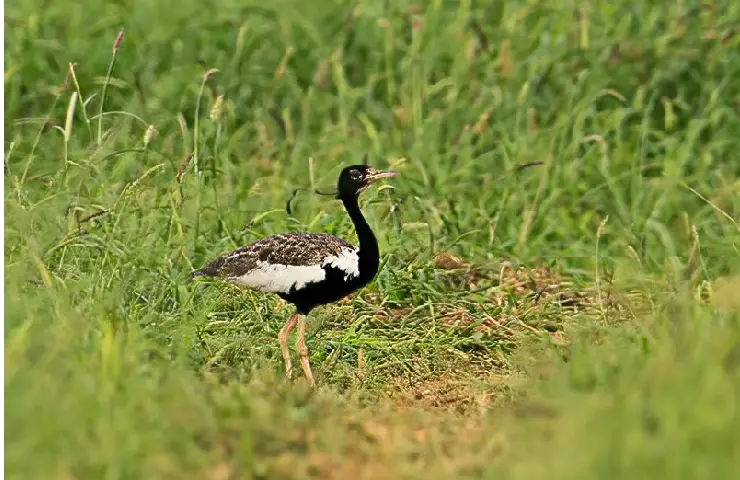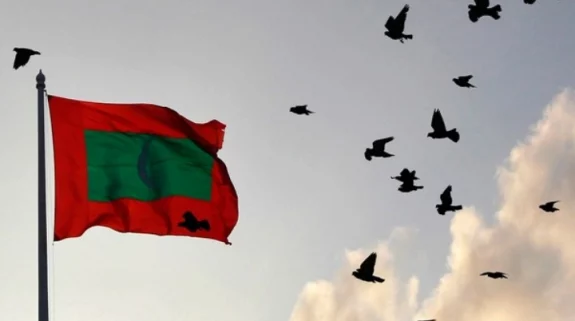Amid the lush green gram (moong) vegetation I was looking for the Lesser Florican—one of the most endangered birds of the country. This was in Shokaliya village near Ajmer in Rajasthan.
After two hours of vigil, and when I was about to give up hope, Chandra Prakash Prajapat, a local team member of BNHS asked me to focus my camera to a spot which was more than 500 meter away. Suddenly, a chicken sized bird shot up in the air, descended, and then rose again.
The Jumping Lesser florican
“It is Kharmor (local name of Lesser Florican) because of the crown that the male has on its head,” Chandra Prakash informed me. In the morning sunlight, the bird’s shimmering black body and silvery white wings appeared stunning. And when they opened, they revealed dazzling colours.
The male florican acquires spectacular breeding plumage and jumps as high as two meters in the air, emitting a frog-like rattle which can be heard from 300-400 meters away. This is part of a well rehearsed ritual to impress potential mates. The females are said to produce a whistling call which attracts males. Males are aggressive towards other males in the neighbourhood.
Watch video
The show stoppers.
Lesser Florican
Blackbuck
V/C @ReddySriramforu pic.twitter.com/FhqgVpSfuo— The Wild India (@the_wildindia) September 6, 2021
The Khamor gives an encore performance every few minutes, bursting on the horizon, displaying its fine plumage, before rapidly descending again. This flamboyant performace goes on 500 to 600 times a day in an effort to attract a mate.
There is sound logic behind the spectacular performance. By leaping 2-3 metres in the air, the Lesser Florican acquires high visibility above the tall grass, falling within the visual range of the female. But she is not impressed easily. Consequently, the male sometimes has to jump around 500 times a day depending on the weather. When it is the florican tires less easily and jumps more. But when the mercury rises, the performance is restricted to the cooler hours of the day. While it is breeding, the male has its distinctive black-and-white colours, but after that it mottle, making the identification more difficult.

In hiding, with just the head bobbing out
“The birds prefer traditional crops like jowar, moong and urad so that they can spot predators given that the crops are at a comfortable height and the female birds can see the males putting on an aerial display during the breeding season,” says Sujit Narwade, Project Scientist with the Bombay Natural History Society (BNHS) who is working on the conservation of the endangered the Great Indian Bustard (GIB).
Supreme Court comes to the rescue of the majestic Great Indian Bustard
But this remarkable mating ritual could soon be history with fewer than 300 lesser floricans remaining in India. It is threatened both by hunting and habitat degradation. The only similar species is the Bengal Florican (Houbaropsis bengalensis) which is larger and lacks the white throat, collar and elongated plumes Even though the government has accorded the Lesser Florican and Bengal Florican the highest degree of protection by putting them under schedule-1 of the Wildlife Protection Act, 1972, their number has consistently declined.
Lesser Florican (Sypheotides indicus) is one of the four bustard species of India, all of which are threatened under the International Union for the Conservation of Nature (IUCN) Red List of Threatened Species, the world’s biggest inventory of the conservation status of biological species. In 2017, Dehradun based Wildlife Institute of India (WII) along with Bombay Natural History Society (BHNS), Corbett Foundation and the forest departments of Madhya Pradesh, Gujarat, Maharashtra and Rajasthan launched the endangered species recovery programme similar to the Great Indian Bustard (GIB) conservation programmes.

Another majestic jump
“We see these birds for three or four months starting from June-July in the Ajmer region, and after that they go south. Now respective agencies including BHNS are working in Madhya Pradesh, Karnataka, Andhra Pradesh, trying to collect data about their possible habitats. Apart from a few random sightings, there is little information about it in the non-breeding months,” says Sujit Narwade.
According to IUCN, the bird, first recorded scientifically in 1782, was found in almost every part of India from Gujarat till Bengal and from the Saharanpur and Mainpuri districts of Uttar Pradesh to Thiruvananthapuram . It also occurred in the Terai region of Nepal, Pakistan, with vagrants being spotted even in Bangladesh and Myanmar.
BNHS researchers hope the Lesser Florican will not suffer the same fate as the great Indian bustard (GIB). Small successes in artificial hatching of lesser florican chicks have brought cheers to the Ajmer forest department that has also drafted a proposal for setting up a conservation reserve dedicated to the lesser florican in a village in Shokaliya.
For endangered tallest bird Sarus Crane UP is “uttam” for breeding




















